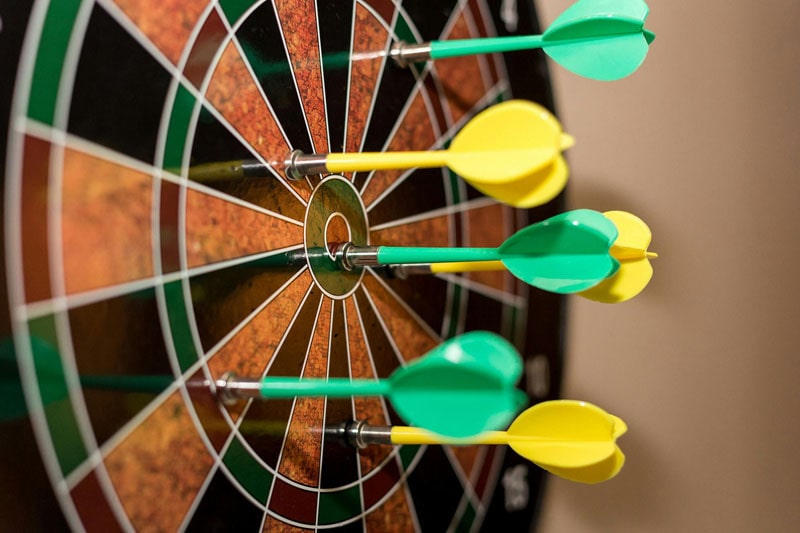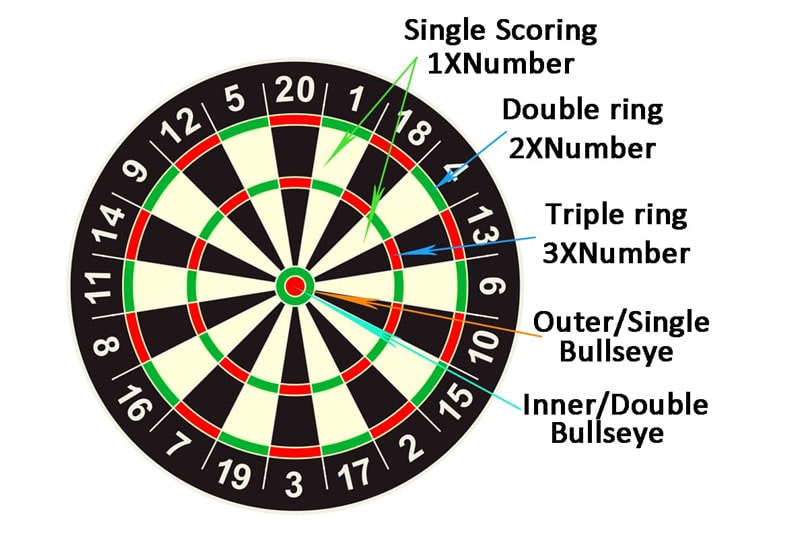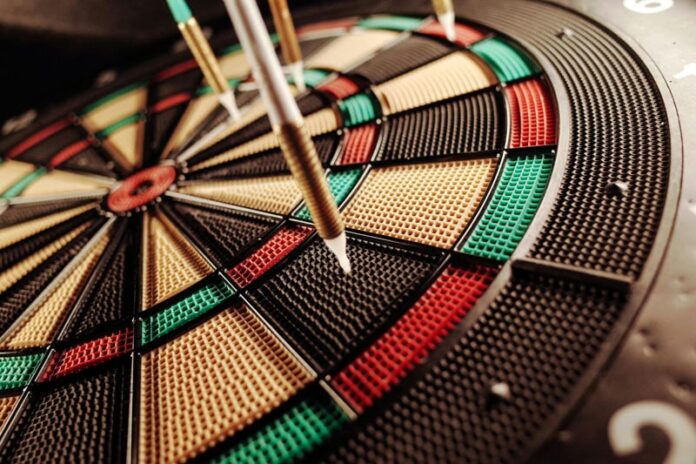Darts is a classic pub game that has entertained players around the world for centuries. Darts is known for its simple setup and engaging gameplay. It involves throwing small, pointed missiles at a circular board with numbered segments. The game looks simple. But, it has many variations and strategies. These keep the game both hard and fun. It’s essential to understand the basic darts rules. They apply to casual matches with friends and to competitive tournaments.
Equipment & Setup
Equipment
Darts is a minimal sport. It requires two basic items: darts and a dartboard.
Dartboard The dartboard is the central piece of equipment in the game of darts. A dartboard has a diameter of 18 inches (45.7 cm) wide. It is divided into 20 numbered segments. Each has a different point value. The board is typically made of sisal fiber, which allows darts to stick better and last longer.
Darts Darts are small, pointed missiles used to score points on the dartboard. Each dart has a metal tip, a barrel (the main body), a flight (the fin-like part), and a shaft (connecting the barrel to the flight). Darts come in various weights, usually from 12 to 50 grams. They can be made from materials such as steel or tungsten. Steel-tip darts are for traditional dartboards. Soft-tip darts are for electronic ones.

Setup in Darts
Throwing Distance The standard throwing distance is 7 feet 9.25 inches (2.37 meters). It’s from the face of the dartboard to the front of the throwing line, also known as the oche. This distance is crucial for consistency in gameplay.
Height and Alignment: Mount the dartboard with the bullseye at exactly 5 feet 8 inches (1.73 meters) from the floor. Ensure the dartboard is level and securely fixed to avoid any movement during play. For electronic dartboards, follow the manufacturer’s guidelines for mounting.
Throwing Area: The area around the dartboard should be clear of obstacles. This will let players throw comfortably and safely. You should have at least 2 feet (0.61 meters) of space on each side of the dartboard for the players’ movements.
With the equipment set up and kept proper, players can enjoy a game of darts. It will be both fair and fun.
Gameplay
Number of Players
Darts can be played by one or more players. In singles matches, two players compete against each other. In doubles matches, two teams of two players each take turns. The number of players can change the game’s strategy and dynamics. The variations apply to team-based and individual play.
Turns and Scoring
Players take turns throwing three darts. They score points based on where their darts land on the dartboard. The dartboard is divided into various segments that score different points:
- Single Segments: The segments on the board score the points marked on them. For example, hitting the segment labeled “20” scores 20 points.
- Double Segments: The outer ring of the dartboard represents double segments. Hitting this area doubles the points of the segment. For instance, hitting the double 20 scores 40 points.
- Triple Segments: The inner ring of the dartboard represents triple segments. Hitting this area triples the points of the segment. For example, hitting the triple 19 scores 57 points.
- Bullseye: The dartboard’s center has two parts. The outer bullseye scores 25 points, while the inner bullseye scores 50.

Popular Dart Games
501 Darts Rules
501 is among the most popular dart games, especially in professional play. The objective is to reduce your score from 501 to exactly zero. Players take turns throwing three darts per round. They aim to hit high-scoring areas to decrease their score quickly. The game is played in a series of legs, where players compete to be the first to reach zero.
Scoring Rules and Strategies
- Scoring: Each throw’s score is subtracted from the player’s total. For example, hitting a triple 20 scores 60 points.
- Checkout: To win, a player must reach exactly zero by hitting a double segment or the bullseye. If a player’s score goes below zero or is not achieved with a double, the turn is forfeited. The player’s score resets to what it was before the turn.
- Strategy: Common strategies include aiming for high-scoring areas like triple 20s. Players also calculate the best way to reach a double for the final checkout.
301 Darts Rules
301 is similar to 501 but starts with a lower score. The objective is to reduce the score from 301 to exactly zero. Players take turns throwing three darts per round. They aim to hit high-scoring areas to lower their score quickly. The game is played in a series of legs, where players compete to be the first to reach zero.
Scoring Rules and Strategies
- Starting Score: A player’s score remains fixed until they land a double segment initially. For example, if a player starts with 301, they must hit a double (e.g., double 20) first. This begins scoring points off their total.
- Scoring: Each throw’s score is subtracted from the player’s total. For example, hitting a triple 20 scores 60 points.
- Checkout: To win, a player must reach exactly zero by hitting a double segment or the bullseye. If a player’s score goes below zero or is not achieved with a double, the turn is forfeited. The player’s score resets to what it was before the turn.
- Strategy: Common strategies include aiming for high-scoring areas like triple 20s. Players also calculate the best way to reach a double for the final checkout.
Cricket Darts Rules
Cricket is a game that focuses on hitting specific numbers to “close” them and score points. The numbers involved are 20, 19, 18, 17, 16, 15, and the bullseye. Players aim to hit these numbers to open and close them while scoring points.
Scoring and Strategic Elements
- Closing Numbers:
- Each number on the dartboard needs to be hit three times to be closed. This can be achieved by hitting:
- Single Segments: Counts as one hit per dart.
- Double Segments: Counts as two hits per dart.
- Triple Segments: Counts as three hits per dart.
- Scoring Points: Once a player closes a number, hits on it score points for that player. They do so until their opponent also closes that number. For example, if a player has closed the 20s and their opponent has not, the player earns points. They get points for every extra dart that lands in the 20-segment.
- Bullseye: The bullseye is split in two sections. The outer bullseye (Counted as single), and the inner bullseye (Counted as single). Hitting the bullseye counts as a hit towards closing it. To close the bullseye, a player needs to hit the outer bullseye three times. Or, they can hit a mix of inner and outer bullseye.
Around the World Darts Rules
The game is called “Around the Clock.” In it, you hit each number on the dartboard in order. The player must hit each number from 1 to 20 to complete the game.
Scoring Rules
- Players must hit each number in sequence. For example, hitting a 1 is followed by hitting a 2, and so on
- Hitting a non-sequence number does not advance the player in the sequence. The player must keep trying to hit the right number from the sequence until they succeed.
- The game is won by the player who completes the sequence in the shortest number of turns. In some variations, players may need to hit a specific segment or double to complete the game.
These popular dart games offer many challenges and strategies. Darts is a versatile and engaging sport for players of all skill levels.
Conclusion
Darts is a game of precision, strategy, and skill. It offers a rich variety of ways to play. Understanding the basic rules and the details of popular dart games like 501, 301, Cricket, and Around the World can greatly increase your enjoyment and skill. Each game has its own rules and strategies. This makes darts a versatile sport for both casual play and competitive matches. You may be aiming for a perfect score. Or, you might be mastering your checkout strategies or just having fun with friends. In any case, knowing the basics of darts will help you in every game. So grab your darts, set up your board, and enjoy the thrill of this timeless game!







